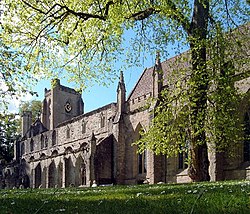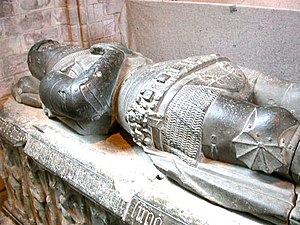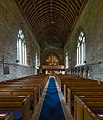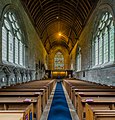Dunkeld Cathedral
| Dunkeld Cathedral | |
|
Dunkeld, Perthshire | |
|---|---|
| Status: | Parish church |
 Dunkeld Cathedral | |
| Church of Scotland | |
| Presbytery of Dunkeld and Meigle | |
| Location | |
| Grid reference: | NO02404258 |
| Location: | 56°33’54"N, 3°35’23"W |
| History | |
| Information | |
Dunkeld Cathedral or St Columba's Church stands on the north bank of the River Tay in Dunkeld, Perthshire. Built in square-stone style of predominantly grey sandstone, the cathedral proper was begun in 1260 and completed in 1501. It stands on the site of the former Culdee Monastery of Dunkeld, stones from which can be seen as an irregular reddish streak in the eastern gable.
St Columba's is today a parish church of the Church of Scotland. It was a cathedral from its foundation in the Middle Ages, serving the ancient Diocese of Dunkeld. It ceased to be a cathedral in 1689 at the abolition of the office of bishop in the Church of Scotland, and the title today is borne merely as an honorific, historical title.
Contents
History
Because of the long construction period, the cathedral shows mixed architecture. Romanesque and Gothic elements are intermingled throughout the structure. Although partly in ruins, the cathedral is in regular use today and is open to the public.
Relics of St Columba, including his bones, were said to have been kept at Dunkeld until the Reformation, at which time they were removed to Ireland.
The original monastery at Dunkeld dated from the sixth or early seventh century, founded after an expedition of Saint Columba to the Land of Alba. It was at first a simple collection of wattle huts. During the ninth century Causantín mac Fergusa constructed a more substantial monastery of reddish sandstone and declared Dunkeld the Primacy (centre) of the faith in Alba.
For reasons not completely understood, the Celtic bell believed to have been used at the monastery is not preserved in the cathedral. Instead, it was used in the Little Dunkeld Church, the parish church of the district of Minor or Lesser Dunkeld. Possibly this was because the later Augustinian canons regarded Culdeeism as heresy, and refused relics or saints of that faith.
In the 11th century, the Celtic Abbacy of Dunkeld became an appanage of the Crown and subsequently descended to the Earls of Fife. Dunkeld Cathedral is today a Crown property, represented in this by Historic Scotland.
In 1689 the Battle of Dunkeld was fought around the cathedral between the Jacobite Highlanders loyal to James II and VII and a government force supporting William III. The latter won the day.
Parish
Dunkeld Cathedral is still used as the town's Church of Scotland parish church, with services every Sunday, although the congregation uses the smaller "Little Dunkeld" Church during winter months.
The small Chapter House Museum offers a collection of relics from monastic and mediæval times, and local history exhibits.
Burials
Alexander Stewart, Earl of Buchan, known as "the Wolf of Badenoch", was buried in the cathedral following his death in 1405, where his tomb, surmounted by his armoured effigy, can still be seen. Other noteworthy burials include:
- John Scotus, Bishop of Dunkeld), (1183–1203)
- Geoffrey de Liberatione, Bishop of Dunkeld (1236/7–1249)
- Richard de Inverkeithing, a chamberlain of King Alexander II of Scotland and Bishop of Dunkeld (1250/2–1272)
- William Sinclair, Bishop of Dunkeld (1309–1337)
- Michael de Monymusk, Bishop of Dunkeld (1370–1376)
- John Stewart, 1st Earl of Atholl, (c. 1440–1512)
- Robert Cockburn, Bishop of Dunkeld (1524–1526)
- Charles Edward Stuart, Count Roehenstart (1784–1854)
Pictures
Outside links
- Dunkeld Cathedral
- 1894 Floor Plan
- Engraving of Dunkeld Cathedral in 1693 by John Slezer at National Library of Scotland
| "Cathedrals" of the Church of Scotland |
|---|
|
St Machar, Aberdeen • Holy Trinity, Brechin • St Mary, Dornoch • St Blane, Dunblane • St Columba, Dunkeld • St Giles, Edinburgh • St Mungo, Glasgow • St Magnus, Kirkwall • St Moluag, Lismore |








